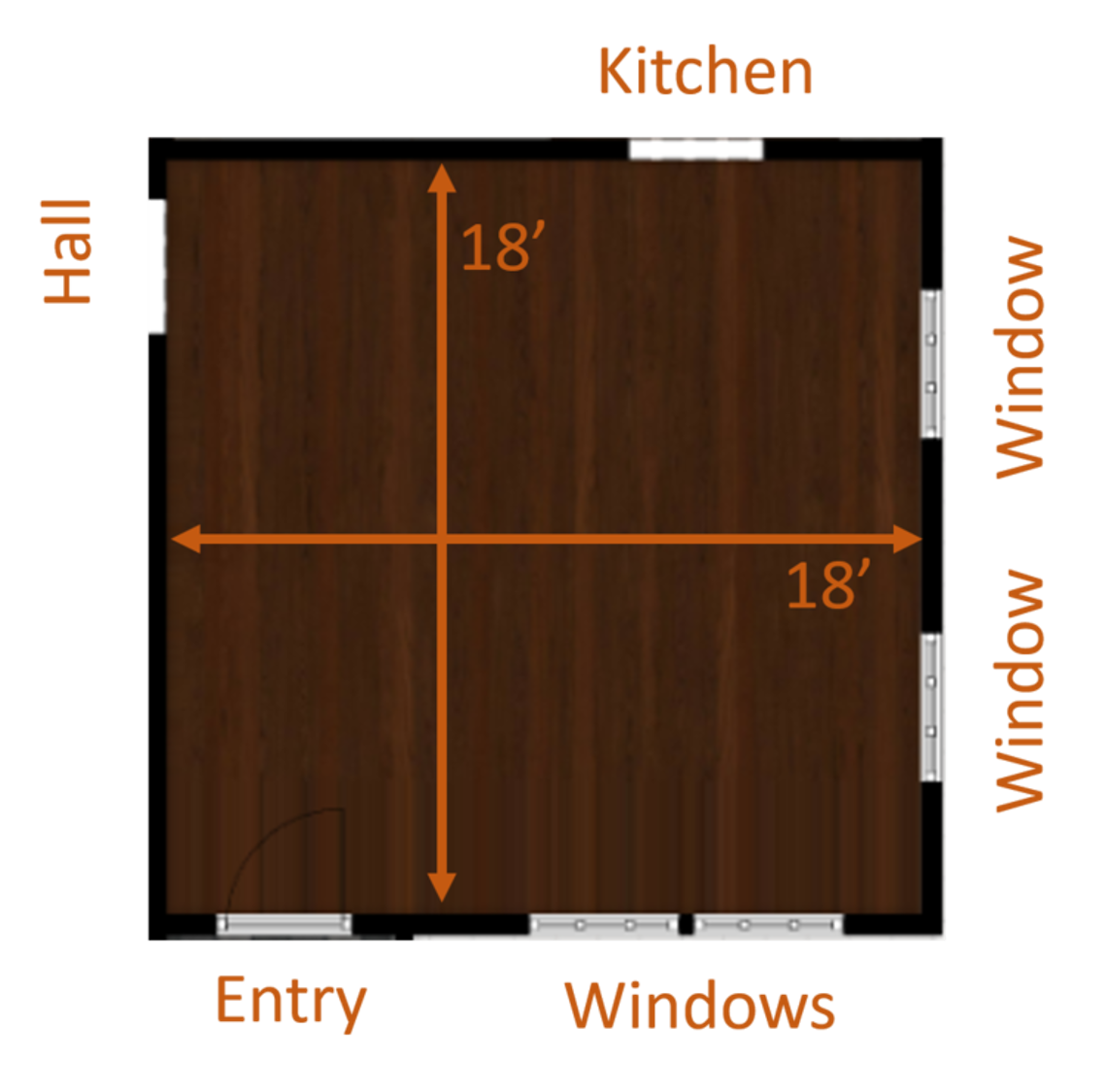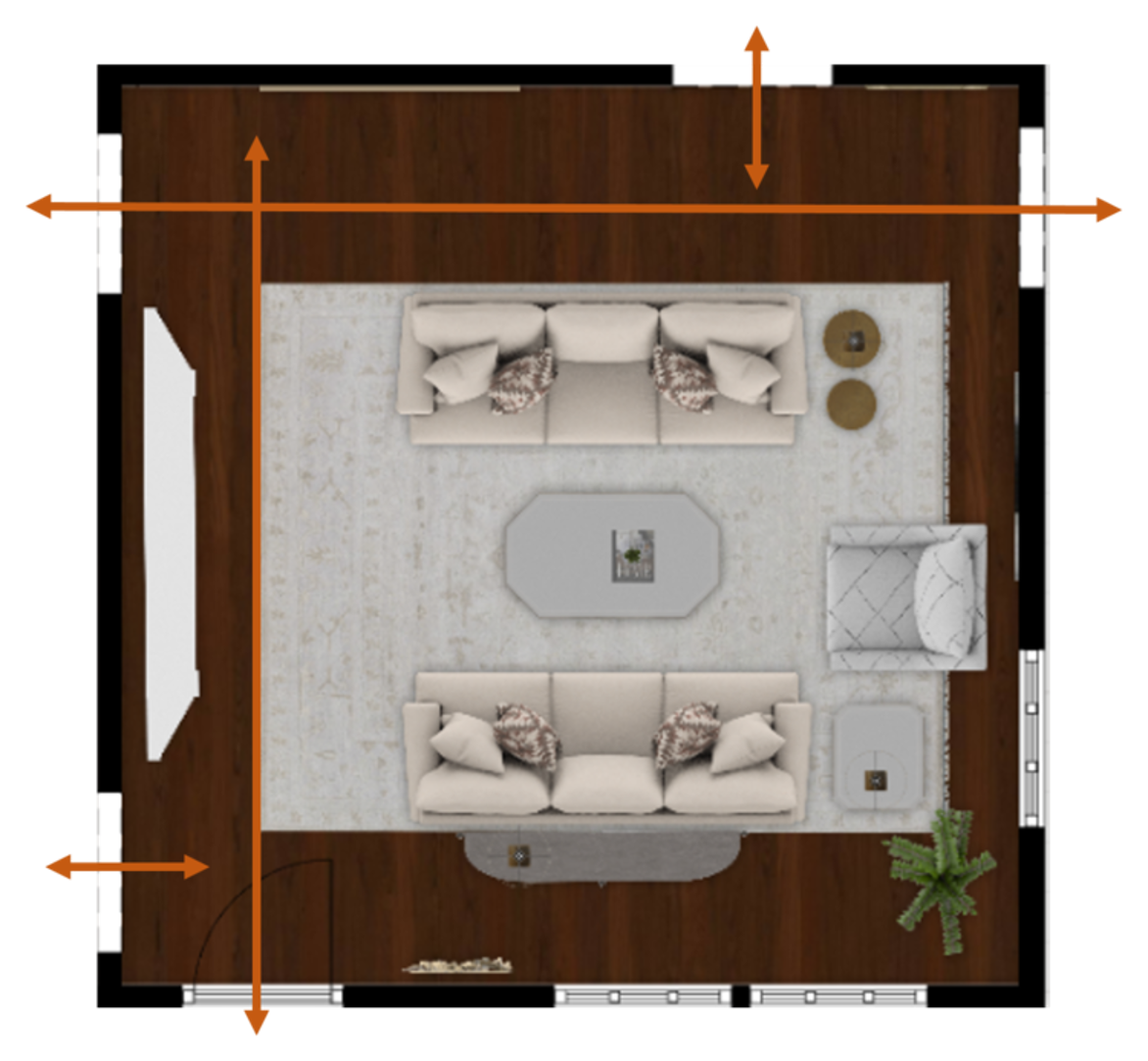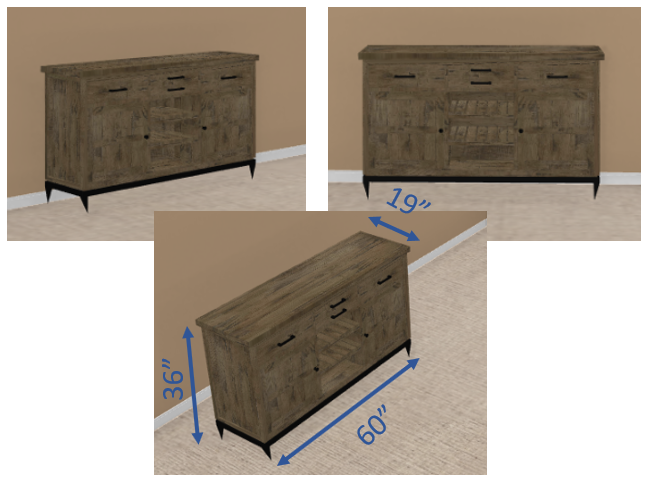Your living room is the central hub of your home, and it’s the place where you entertain guests, watch TV, and relax after a long day.
But, if you hate your living room because it’s awkward or doesn’t feel like it represents your style, it can really put a damper on how you feel about it.
In this post I go over some of the most common things I hear from clients about why they’re frustrated and fed up with their tricky, awkward, or small living rooms.
To give you a sneak peak, many of the things I hear have to do with: awkward shaped living rooms, furniture that just doesn’t fit the room or style, and the fear of spending money on furniture that they’re not sure will look good, fit, or function how they want it to.
Can you relate to any of these? If so, I’m going to give you my best advice to help you solve these types of problems and so much more. Let’s get into 8 tips to transform your awkward living room into your dream space.
Awkward layout:
Sometimes it’s the room itself.
You may have a tricky floor space, or multiple doorways - that make it tough to position furniture. Maybe your troubles stem from architectural obstructions - like bump-outs, bump-ins, a large fireplace, or radiators that stick out into the room.
Michael Helwig Interiors
A living room with an awkward layout can make it difficult to not only arrange furniture, but to create flow, and a comfortable feeling.
Here are some of the more common issues with an awkward living room layout and what to try to solve them:
Limited seating options: Limited seating can make it frustrating to host guests or enjoy activities like movie watching or game nights. If all your seating is pushed off onto the walls or stuffed into corners, a nice visit can be tough.
Try this: Instead of trying to position furniture around these tricky spots, position the furniture in the center of the room. This is called a floating furniture configuration. Now, you may need to swap out some of the pieces that you currently have to make this work. This is especially true if you want to get the best function for the space.
Michael Helwig Interiors
You can’t put a square peg in a round hole. The same can be said for a giant sectional that you’re trying to cram in between a tricky small corner with limited view of your TV or important focal point, right?
Obstructed views: An obstructed view can make the living room feel cramped and uncomfortable.
This goes back to putting the sectional in the awkward corner. It can block the view of the rest of the room, making it feel disconnected and disjointed.
Lisa Fotios
I once had a client who placed her TV and media console in front of her picture window overlooking her beautiful gardens. She was convinced this was the best spot for the TV even though it obstructed her pretty view. What started to happen was that she resented the room layout so much that she almost completely avoided going into the room at all. The trade off between the TV and the view became a hot button issue.
So, how do you fix a problem like an obstructed view?
This is about editing. If you have an issue similar to this, I would guess that you either have too much furniture in the room or furniture that doesn’t fit appropriately in the space, too big would be my guess.
Michael Helwig Interiors
So, start with measuring the room so that you know EXACTLY how much space you have.
Measure the furniture that you have in the room: length, depth, width, height. This will show you the space you have to work with: the room dimensions, and what can fit.
Michael Helwig Interiors
The editing is the tough part, sometimes you’ll need to swap out furniture to get the best fit. If you think about gaining the function and feeling that you want, the editing process isn’t as hard.
When I moved into my house, I wanted a sectional in the worst way. The trouble is my living room is very narrow, with a large radiator in the center of the outside wall, under a picture window. It was a momentary disappointment to not get the sectional, but if I moved forward anyway, ignoring the fact that it wouldn’t fit, it would’ve caused bigger issues. Not worth the hassle, IMO.
Poor traffic flow: A living room with poor traffic flow can make it challenging to move around comfortably. This is about furniture that’s obstructing doorways, not having enough room to move around and in between furniture, or furniture that blocks the ideal pathways through the room.
Max Rahubovskiy
Let’s take the example of a ‘pass-through” living room. This is where you have multiple doorways on 2 or 3 walls. Maybe the front door is on the first wall, then you have a hallway to bedrooms on another and then the large opening to the dining room and kitchen on the 3rd wall. This room is the pass-through to all the other spaces in the house. But you still need it to function as a living room: seating, end tables, lamps, TV etc.
Try this: The best medicine for a room like this is to know the full measurements. (You’ll start to see a pattern here if you haven’t already….) Knowing the size of the room is going to help you map out what will fit.
Some key dimensions to keep in mind:
You need a minimum of 3 feet to walk into the living room form each doorway. That means, keep furniture out of that pathway for at least 36”.
30” to move around furniture in the room. Say you have a tall cabinet that has doors. To open the doors adequately, leave that 30” between the swing of the cabinet door and an adjacent piece of furniture: end table, sofa arm, chair, etc.
You’ll need 14” to 18” to walk around the coffee table and the sofa, chairs etc. This is the ideal “reaching distance” for a seated position on the sofa or chair to the coffee table as well.
2. Dull or outdated decor
If the living room feels outdated or lacks personality, it can be challenging to want to spend time in it.
If your living room has a case of the ‘blahs’, you’ll know exactly what this one is all about.
Maybe you’ve had your furniture for a long time, and it’s gotten to look shabby. Years of wear and tear, scratches, knicks, cracks, oh my! Perhaps you bought a new sofa, and the rest of your stuff suddenly looks ancient and grubby. (Been there!)
Give this tip a shot: Make a list of what you want to see happen in the space. This is all about dreaming. You’d be surprised how a little fantasizing about the room of your dreams can put you on the path to making it happen. You might not want to or can afford to do everything on your dream list at once, but you’ll certainly be able to see what’s possible right now.
Start simple. Get a new area rug. I’ve said it a million times, an area rug defines seating spaces, and can be the inspiration for art, upholstery, accents and even a new wall color.
Start even more simple: buy some new pillows for the sofa. Invest in a piece of mid century modern art, or a new mirror for the room.
These are little steps that prime the pump for a bigger project down the line.
3. Uncomfortable furniture
Uncomfortable furniture can make it difficult to relax and unwind in the living room.
A lumpy sofa. A chair that lost its support. A new piece of furniture that isn’t comfortable, super annoying, right?
My beloved grandma had a beautiful read velvet chair with intricate wood carvings. She bought it on time in the 1950’s or 60’s. Over the decades, the springs got out of whack and the fabric became worn and very thin in spots. A once beautiful chair became uncomfortable and unsightly.
coventrylaneupholstery
Try this: If you have a piece that you desperately love and can’t bear to part with, it’s probably time to take it to a reupholstery pro or a furniture refinisher. They can bring it back to life and make it look like new again. It will be just as expensive as a new piece, sometimes more… But you’ll be keeping that sentimental piece in the family and out of the landfill. Best of all, a good professional furniture restoration pro can even increase the value of a piece. That means, the new value could outweigh the cost of the work.
4. The sunk cost fallacy
This is a cognitive bias where people continue to invest time or money in a project, even when it's no longer in their best interest to do so, because they've already invested so much.
In the case of a living room with outdated decor, people may feel reluctant to make changes because they've already spent a lot of time or money on their current decor, even if they no longer like it.
This goes right back to my grandma’s chair story. Because she paid for the chair on store credit, making payments over time, she couldn’t part with it even when it was falling apart. “That’s an expensive chair!”, whenever I would complain about how uncomfortable the seat was. When the fabric started to wear through, that was it… she allowed no more butts on the chair. It was a lonely, unused chair in the corner for the rest of its existence.
Do this instead: You must ask yourself if the piece is important to you because it’s sentimental. If so, invest in the repair of it. Don’t let it take up space just because it was an expensive piece in the beginning. You know what they say when you drive a car off the lot, it loses its original value right after… The same can be said for a decades old accent chair, sofa, or tables. The gut test of whether it’s sentimental or just taking up space is the best measure for what to do with it going forward.
5. Lack of natural light
A living room that lacks natural light can feel gloomy and uninviting.
Maria Orlova
The impact of natural light on human mood and behavior is a well-researched topic in the field of environmental psychology. Several studies have found that exposure to natural light can positively affect mental health, cognitive function, and overall well-being.
For example, a 2022 study published in the Journal of Environmental Psychology found that exposure to natural light was associated with greater satisfaction with one's living environment, while a lack of natural light was associated with lower satisfaction.
Another study from 2021, published in the Journal of Sleep Research, found that exposure to natural light during the day was associated with better sleep quality at night.
So, open those window treatments! If you’re windows are constantly covered, you’ll perpetuate any lingering feelings of dislike for your living room. You can always close drapes, shades, blinds, or shutters at night when you want privacy or when you need light control. Exploring plantation shutter types can also add a stylish, functional touch to your living room, offering both light control and a sophisticated finish. They’re decorative and functional, they can show off your style choices, just don’t leave them closed all the time. If you’re looking for shutters that offer both protection and style, hurricane shutters Brisbane can provide an added layer of security while complementing your home's design.
6. Clutter:
A living room that’s cluttered or disorganized can create a sense of chaos and stress.
Clutter can make the space feel cramped and disorganized and make it difficult to relax and enjoy the room.
Piles of paper, tech and all its paraphernalia stacks of books, newspapers and magazines keep you in touch with the world, but all this stuff creates physical and visual clutter in the room. Instead of enjoying the time and relaxing, you’ll want to tidy up. The trouble is that clutter tends to pile because it has no place to go, or it’s accumulated so much that you forget where it’s supposed to go.
I love magazines. Some would call my collection an obsession. Others might think, it’s tame. I can tell you that I HATE to part with a magazine because they’re filled with oodles of inspiration and ideas that I can riff on. But, when I start piling them up in other places outside of the decorative boxes - that I keep them in on my shelf, it’s time to purge!
If you have a similar issue, no matter what the clutter is, do this instead:
You must develop a system for organizing and maintaining the space:
1. Start with a deep clean: Get rid of any items that are no longer needed or wanted. Then clean the area well so that you’ve put sweat equity into the practice. This will make it harder for you to mindlessly pile things later.
2. Create designated storage areas: Everything in its place. Figure out the best place for items like books, magazines, or tech devices and don’t let them spill out from those storage spots. It takes time to develop a habit, so don’t be too hard on yourself when starting a decluttering habit. Just keep at it.
3. Minimize decorative items: While decorative items can add your personality to a living room, too many can make the space feel cluttered and overwhelming. Pair them down by choosing those that have the most impact or sentimental value.
4. Regularly declutter: Regularly decluttering the living room can help prevent clutter from accumulating. Schedule regular times to go through the space and get rid of any items that are no longer needed or wanted. Stick to the schedule and be ruthless!
This leads me right into the next complaint:
7. Limited storage
Limited storage space can make it challenging to keep the living room organized and tidy.
Skylar Kang
It’s great to talk about how decluttering can transform a tricky, awkward living room into a space you’ll love, but what if there’s no immediate place for the clutter to go? That can add another layer of stress.
Here’s what to do:
I love furniture that does double duty in a small or tricky room.
Storage ottomans are great for storing clutter. They have a hinged top that and an interior that is wide open. So, this is a great place to store magazines, tech, games, extra blankets, and pillows. Things are out of site and right at hand when you want them.
Baskets and decorative boxes: these are decorative and functional. Store papers, magazines, crafting supplies like yarn for knitting, patterns for sewing projects. Video games, controllers, remote controls, you name it!
I love a storage cube ottoman. These are great for extra seating and can be tucked under a console when not being used. Inside you can corral a plethora of homeless clutter to get it out of sight in a jiffy!
Cabinets and etageres: I love a cabinet with some open storage on the top and a couple of closet door cabinets on the bottom. Every room needs a place to hide the clutter and those closed doors are just the ticket. Plus, the open shelves on top make a great place to display important treasures. Just don’t over crowd them.
8. Color scheme
If your living room's color scheme is not pleasing to your eye, it can make the space quite unappealing.
Devon Janse van Rensburg
The wrong color scheme can make a living room feel uninviting, dreary, or chaotic.
This happens a lot when you inherit a wall color from a previous owner. You may have found the perfect house with the best “bones” around, but if you’re a neutral color person and the old people were bold color people, you might be thrown until you can make a change happen.
Just remember, paint can change the entire mood of a room for very little cost.
Here are some tips for choosing a color scheme that works well for your living room:
1. Start with inspiration: Begin by finding inspiration for your living room's color scheme, whether it's from a rug, a favorite painting or some other inspiration that will live in the room.
2. Choose a dominant color: This color will be the foundation of the color scheme. This color should be used in larger quantities than any other color.
3. Add complementary colors: Complementary colors are those that are opposite on the color wheel. Adding these colors to the dominant color can create a harmonious and balanced color scheme.
4. Consider the mood: Think about the mood you want to create in your living room. Do you want it to feel calm and relaxing or energetic and vibrant? Choose colors that reflect the mood you want to create.
5. Test it out: Before committing to a color scheme, test it out in the living room by painting a small area or adding some inexpensive accents like pillows or pottery. This can help you see how the colors look in the space and make any necessary adjustments.
6. Try the 60,30,10 rule: This will help you to keep your color selections streamlined and in the most effective balance for the room.
Here’s a bonus tip that deserves an honorable mention:
(9) Trying to fit old furniture in a new room
Trying to fit old furniture into a new space: Oh boy. This one is always a rough one. You move into a new house where your old furniture – stuff that you like, and stuff that was expensive, but doesn’t look right in the new house.
Michael Helwig Interiors
You try to arrange the room 8 different ways. You get tired of shoving and hauling stuff around, and you decide the “best” way it can go- even though you hate it…. You live with it, and the resentment grows. Soon you find that you’re not spending as much time in the room because the space ticks you off.
Does this sound familiar?
I’d say this is a layer of 3 of the previous complaints above: Outdated furniture, Uncomfortable Furniture and Sunk Cost Fallacy
The room might be stressing you out because the furniture looked great in the old house: perfect color, right style, perfect fit. In the new house, the color looks terrible, it’s the total wrong style and the fit is way off. That means, regardless of the newness of the furniture, it’s outdated.
The fit not working is a functional problem, which translates to uncomfortable. If you must position your body in an awkward and uncomfortable way to see the TV, that uncomfortable position will get old fast.
You feel guilty because the furniture is relatively new and wasn’t cheap: sunk cost fallacy.
A manager I had years ago used to say: Why would you put old tires on a new car? That’s how he related the old furniture in a new house scenario. It rings true, right? That doesn’t mean start fresh with everything, it means plan for what you to take.
What to do instead: Before moving into the new house, take a day to measure the whole place, all the rooms. That way you’ll know exactly the size of each room and what can possibly fit in each as well. If you can avoid having to move something that doesn’t fit, and you can sell it, or give it to a friend or family member, all the better.
So, there you have it. My most heard about reasons for people hating their tricky awkward living rooms. As you can see, it’s mostly about “easy” fixes, not tearing out walls or sealing up doorways to create a different room orientation. Most of the time it’s not even about the room at all. And, I’d venture to say the things that frustrate you the most about a tricky living room are some of the characteristics that you fell in love with when you found the house to begin with… It’s just that we discover the trickiness later after we’ve moved in.
Do you have other reasons why you hate your awkward living room? Leave me a comment below and tell me all about it. I read all the comments and answer each one too!
Read Next
The curved furniture trend is hot this year. But, for small and tricky rooms with angled walls it could be the very best solution to get maximum seating, optimal flow and superior function. Let’s explore a shared living room and dining room where every piece of furniture has rounded curves.
Join the Fun!
If you enjoyed this post and you want to keep seeing my weekly blog, the best way to do that is to subscribe.
You can subscribe by downloading my 11 Secrets Only Designers Know to Make Your Space Rock. If you’re curious about how decorators and designers make a home look magazine ready, you’ll love taking a gander at these 11 secrets. You’ll learn how to style your room from the floor up and it will work for ANY space you have.
I write about small space design and decorating, sustainable furniture options, positive self care and a variety of do-it-yourself home décor.
I’d love to connect with you!
“Michael Helwig was top-notch, very professional and responsive to my needs. He allowed me time to explore ideas and try out a variety of combinations until we found the perfect fit. Michael provided detailed information and offered beautiful ideas to make my dream living room become a reality. The furniture he sourced has totally transformed my living room space. Everyone that has seen my new living room has one word, WOW! A special thank you to Michael for a wonderful experience.”
“Michael was very knowledgeable and guided us, with great patience and good humor, through the process of designing our dining room and helping us find the perfect sleeper sofa. He offered really helpful advice when we asked questions - which was often - but at no time did we ever feel pushed. He helped me when I felt like I couldn’t make one more decision. When my new furniture finally arrived I realized everything down to the pillows was perfect. I couldn’t be happier!”
Anna Tarazevich
Michael is Principal designer and blogger at Michael Helwig Interiors in beautiful Buffalo, New York. Since 2011, he’s a space planning expert, offering online interior e-design services for folks living in small homes, or for those with awkward and tricky layouts. He’s a frequent expert contributor to many National media publications and news outlets on topics related to decorating, interior design, diy projects, and more. Michael happily shares his experience to help folks avoid expensive mistakes and decorating disappointments. You can follow him on Pinterest, Instagram and Facebook @interiorsmh.





















